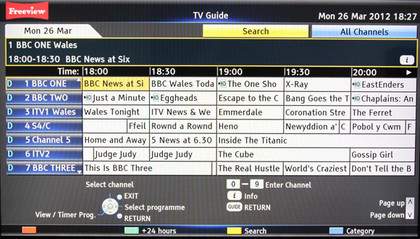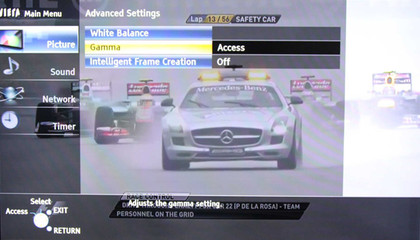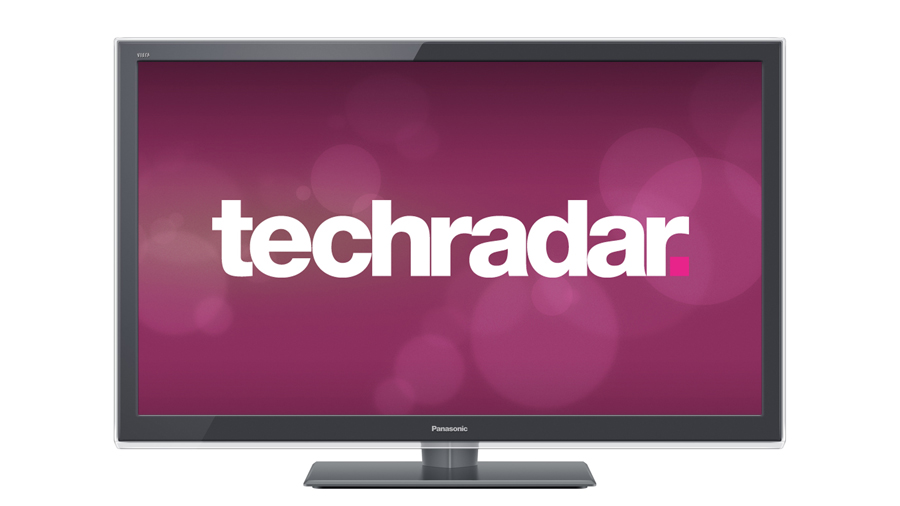Why you can trust TechRadar
The initial set-up is a cinch; choose your country, and the TX-L37ET5 immediately goes into DVB-T2 mode, tuning-in as many digital TV channels as it can find. In our test it found the entire roster of SD and HD channels inside a few minutes, and ordered them by signal strength.
The latter is useful if you plan to use the TX-L37ET5 in a room with dodgy digital TV signals (we've all got one of those). The TX-L37ET5 then gives us a choice of linking to a wired or wireless network before performing a short connection test.
The success of the user interface hangs on a remote control. The one that ships with the TX-L37ET5 is a slightly smaller version than in previous years, and more like the style included with Panasonic's Blu-ray players.
Smaller numbered buttons is the biggest change, which will make VIERA TVs instantly less appealing to those with poor sight. Ironically, the TX-L37ET5 does have an all-new Voice Description feature, which works by announcing on-screen information using synthetic speech and gives clear instructions on how to navigate around the TV menu.
Elsewhere the remote seems a little lop-sided; the usual navigational arrows and OK button are flanked by the less-than-necessary VIERA Tools shortcut, and buttons for Internet (VIERA Connect) and Guide (Freeview), while the more important Menu button is more anonymous.

The 8-day Freeview guide is strictly functional, with a spreadsheet look to it that covers two hours of scheduling for seven channels, killing both picture and sound when activated. How quaint. Selecting a programme to watch is somewhat fiddly, too, with a screen popping-up offering to set a view or set a timer to record; the latter ought to be assigned to a coloured Fastext button, though at least it flags-up the TX-L37ET5's ability to record Freeview programmes to a docked HDD or USB thumbdrive.
VIERA Connect is the finest smart TV interface around, at least in looks. The nuanced graphics and the recessed, almost 3D look to them is really quote stunning although moving between the separate screens is a bit of a pain. It's best to spend a bit of time customising exactly where the icons for each app go so to keep all of your favourites on the start-up screen.
From a networked PC we managed to stream AVC HD, MOV, MP4 and AVI video files, FLAC and MP3 music, and JPEG photos, while from USB it also supported MKV video.
Sound
With two 10W speakers the TX-L37ET5 is perhaps a tad more powerful than most 37-inchers, and it results in a typically (for Panasonic) impressive - that's to say, just above average against some pretty lowly competition - audio performance.
A shortcut on the remote control for Surround toggles between 'normal', V-Audio and V-Audio Surround modes. The latter splices-up the soundstage but never lives up to its name; best rely on V-Audio, which provides a consistent and versatile balance that gives a fuller sound to dialogue, just enough mid-range and fake bass for the odd film to sound acceptable, and a decent stereo image.
It's hardly a replacement for a decent soundbar or home cinema, but it's a good all-round performance that will suit a lot of smaller living rooms. There's also a music setting, which is more engaging for tunes.
Value

Panasonic is selling the TX-L37ET5 for a touch under £850, though a quick browse online finds it for as little as £749. That's fair value for a nicely design TV that's fitted not only with a family-friendly, convenient 3D system, loads of online goodies on VIERA Connect and some reasonable networking and even recordings features.
Chuck in a generous collection of ins and outs that will allow changes in set-up and situation, and we'd judge this a good value all-rounder, though we wouldn't be surprised if another £100 fell-off the price soon - something that would make this an almost unbeatable proposition for a family living room.
Jamie is a freelance tech, travel and space journalist based in the UK. He’s been writing regularly for Techradar since it was launched in 2008 and also writes regularly for Forbes, The Telegraph, the South China Morning Post, Sky & Telescope and the Sky At Night magazine as well as other Future titles T3, Digital Camera World, All About Space and Space.com. He also edits two of his own websites, TravGear.com and WhenIsTheNextEclipse.com that reflect his obsession with travel gear and solar eclipse travel. He is the author of A Stargazing Program For Beginners (Springer, 2015),

